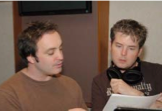
LucasArts voice director Darragh O’Farrell directs David W. Collins in a voice acting session for the upcoming THRILLVILLE.
WHEN RECORDED DIALOGUE FIRST CAME to the big screen, the film industry changed overnight. By contrast, the advent of recorded dialogue for games has been a slow trickle over the last three generations of gaming technology. Only now is voice finally approaching “must-have” status for developers and consumers. As such, voice is a new challenge for many developers. Even for seasoned audio professionals, recent advances in technology mean that game dialogue is still a rapidly expanding area of game design.
Voice comes in three distinct flavors. Conversational dialogue is the bulk of any game’s voice system and covers story, tutorials, cutscenes, sports play-by-plays, and any other linear in-game voice. Utterances are voice files that include hit impacts, taunts, and other short, non-linear pieces of dialogue. Localization is the process of translating your domestic voice set into foreign language sets for European and Asian markets. Each area of voice represents its own unique set of challenges. This month we’re going to focus on the process of producing convincing conversational dialogue.
PREP TIME
METAL GEAR SOLID, RATCHET & CLANK, and the MADDEN series all share one thing in common. At the heart of each is a conversational voice system that delivers critical information to the player about story, setting, characterization, and progression through the game. With games continually growing in size and scope, even a small game these days will contain thousands of voice lines. These thousands of lines are recorded one character at a time with fragmented scripts that are often performed out of context and without the benefit of any rehearsal time for the actors.
Though most practical and efficient, this approach is counterintuitive to the goal of cohesive conversational dialogue. Far too often, the result is a voice system riddled with dialogue that sounds glaringly unnatural. Wrong words are stressed for the actual meaning of the sentence. Emotion levels don’t follow normal human speech patterns. At its best, badly done dialogue is simply an awkward annoyance to the player. At its worst, it becomes fodder for endless internet mockery.
TOOLS OF THE TRADE
There are two invaluable tools that are a script’s best allies. The first is a robust dialogue database using database management software such as FileMaker Pro or Microsoft Access. Each record in the voice database represents an individual line of dialogue and contains fields to denote critical information for each file such as character, level, a unique filename, and the line of dialogue itself. Additionally, each conversation in the game should be numbered with a unique conversation ID number. Each line of dialogue within a conversation is then given a unique dialogue ID number. When the writer delivers the script, it should be delivered as a Microsoft Excel document within which a separate column represents each of these distinct database fields. This spreadsheet is then imported directly into the voice database.
Once imported, the database can be used via macros to search for and sort by conversation IDs and dialogue IDs, organize these lines by character, and output them as a theatrically formatted script where conversational voice is preceded and followed by lines that help to give context and meaning to otherwise disjointed sentences.
Additionally, don’t discount the benefits of simply formatting a script’s text so as to portray intention. Take this line, for example, when the character Bastila Shan says: “The Force fights with me!”
This line of dialogue from STAR WARS: KNIGHTS OF THE OLD REPUBLIC represents the inherent ambiguity of a game script. Taken completely out of context, the intent of the sentence is unclear. Is “Force,” “fights,” or “me” the main point of the sentence? Each one radically changes the meaning and delivery of the line. The standard arsenal of punctuation —in addition to bold, italic, and underlined text—will go a long way toward communicating performance intent.
THE RIGHT DIRECTION
The second secret weapon in your arsenal should be a dedicated voice director. A voice director is tasked with running the recording session and represents the last bastion of quality control over dialogue before it’s edited and implemented. As such, it’s the voice director’s responsibility to ensure that lines are recorded as written, all performances are convincing, and critical issues such as pronunciation of character, planet, or weapon names are consistent and correct.
It’s important to note that your voice director should have previous game experience. Game voice is a very different beast from traditional animation. A single line of dialogue might be heard thousands of times over the course of a game. A game voice director should be savvy enough to know which is the right take for a game, and which is going to drive players crazy or not serve the game well.
In the end, every step you take to ensure clarity of intent will bring the script closer to being cohesive and convincing. By taking care to meticulously prepare the script and place it into the hands of a professional voice director, you give the script its best chance of fully engaging both actors and audience.
